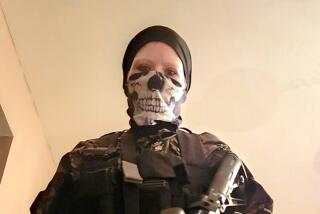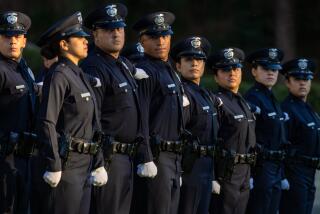Are Terrorist Suspects Duping Us?
- Share via
RESTON, Va. — As we approach the nation’s first Fourth of July celebration since the Sept. 11 tragedy, a recent CNN-Time magazine poll shows that many Americans believe that terrorists will strike somewhere in the United States on Independence Day.
Beyond that, the public hasn’t a clue about the specifics of the threat; nor do many bother to know the color-coded threat level of the day. This is not because Americans are uninterested in the war on terrorism--the opposite is markedly true. It is because they are utterly confused by endless, plainly incomprehensible government alerts or cannot incorporate into their lives conflicting information slickly packaged by a new crop of dubious “terrorism experts” in the broadcast media.
Increasingly, the public suspects that the warnings are being issued by a government more driven by self-protection than by the security of its citizens, as each new warning is conditioned by the tortured construct “out of an abundance of caution.” Today’s threat level is, by the way, yellow, which means “elevated,” which means that “there is a significant risk of terrorist attacks.”
That can’t be good enough.
Much of the confusion can be linked to the difficulties of interrogating 500 or so detainees now in U.S. or allied custody. Getting the truth out of committed terrorist insiders is difficult enough, often impossible. In the case of Ramzi Yousef, the convicted mastermind behind the 1993 attack on the World Trade Center, U.S. authorities learned nothing beyond the ominous warning that the job on the twin towers would one day be finished. Zacarias Moussaoui, the indicted “20th hijacker” suspect now facing trial in connection with the Sept. 11 attacks, has, similarly, given up nothing of value. Both men were in total isolation and under the complete control of U.S. authorities for months (Moussaoui) and even years (Yousef).
But getting the truth out of the current crop of detainees in U.S. custody presents another, in some ways more troublesome, challenge. Few of the men we hold in Afghanistan or at Guantanamo Bay are known quantities, genuine insiders with the crucial information we need to prevent another outrage. Yet they all have been exposed to enough of the Al Qaeda lore to keep us at an elevated state of alert. The detainees’ common “cover story” is a composite based on their rote memorization of the Islamic Jihad encyclopedia and training manual, liberally sprinkled with scuttlebutt from Al Qaeda training camps in Afghanistan. The training manual, it seems, is the likely source of most of the threat alerts keeping the nation on edge.
A 5,000-page handbook that runs from dangerous (cut-and-pasted U.S. Army training manuals) to silly (wildly errant instructions on how to make a nuclear fusion device), the training manual has been found on compact discs and in printouts in dozens of Al Qaeda safe houses in Afghanistan. It was apparently left lying about as sort of a Gideon’s Bible of terror. It contains most of the target information central to the alerts of the last several months, including nuclear, gas and electric power plants, bridges, dams, airports, railroads, skyscrapers, the U.S. Capitol, football stadiums, apartment buildings and banks.
U.S. intelligence has had the manual for about five years and has known it recommends skyscrapers, nuclear plants and crowded football stadiums as the best targets for spreading fear. The handbook also lists targets of “sentimental value”--the Statue of Liberty, Big Ben in London and the Eiffel Tower in Paris, for example--as well as advising attacks on major public gatherings such as Christmas and Fourth of July celebrations.
Those who interrogate the men held in Pakistan, Guantanamo Bay or other locations and then process the intelligence--and who ultimately issue the warnings--must always be concerned that they may be simply recycling and reconfirming the threats contained in the manual.
When, in Pakistan, alleged Al Qaeda kingpin Abu Zubaydah speaks of plots to attack the Statue of Liberty, another detainee at Guantanamo Bay or in Morocco admitting he knew something about such a plan cannot automatically be taken as a confirmation. Even an abundance of caution need not lead to calling the nation to general quarters every time a few detainees say the same thing.
Another problem involves contamination. In the cases of the prisoners from Afghanistan and Pakistan, their first experiences with hostile interrogation will have been at the hands of the U.S. military. They would have been aggressively questioned on the locations of key Taliban or Al Qaeda personalities and on threats against U.S. forces.
The interrogators probably lacked a genuinely deep familiarity with the cultures and settings of the prisoners, who almost always answered through interpreters. By the time the detainees were sent to Guantanamo Bay, they understood the strengths and weaknesses of their interrogators and their interpreters, and many would already know what information could be given up without opening themselves to reprisals. As a result, there seem to have been repeated “confirmations” of much of the information we already knew years ago in the Islamic Jihad training manual.
Are we being duped or is this just the nature of the challenge? It is probably a bit of both, and we have to get a grip on it.
In 30 years in the CIA’s Operations Directorate, I can count on both hands the number of men and women I would consider true experts in the art of interrogation, a handful of Americans and a few from friendly intelligence services. In every case where I saw a genuine breakthrough in a terrorism interrogation, it came after months of patient probing, mind games and manipulation. Invariably it involved a completely isolated detainee who ultimately bonded with his interrogator.
One such interrogation by an intelligence service in a friendly country took months of patient “reality adjustment.” The terrorist, a man captured at the scene of a terrorist act, and whose guilt was never in question, was held in total isolation. Over the months, his interrogator gradually fed him bits and pieces of fabricated newspaper accounts that rewrote the history of the months since he had been captured. The detainee was never openly confronted with the newspapers; instead, he was allowed to catch a furtive glimpse of them every couple of days while the interrogator’s file lay “carelessly” open across the table.
Gradually, however, the terrorist developed a totally contrived picture of his world. The first faked news clips told of U.S. military strikes against his homeland. Then the dictator to whom the detainee had sworn allegiance went missing, then he was reported gravely wounded. Finally, the detainee’s personal idol was reported dead from his wounds. The terrorist’s world collapsed, and he turned to the only human being left in his new world, his interrogator. He calmly told him the whole story.
The process took a year.
We will have to be patient. To counter the confusion, we need a national dialogue on the war against terrorism, one that will include a candid discussion of what is known, what is not known and what may never be known about our enemy. Part of the dialogue must be what should be shared with the public, when and why, and what should not be shared and why not.
To carry this off, we need a reliable interlocutor, a Rudolph W. Giuliani-type national figure, who would speak clearly on the nature of the enemy and of the threat and who would be believed when he spoke. This terrorist threat against America is real. It will be with us for a while, but if we settle down and get control of the challenge, we’ll beat it back.
More to Read
Sign up for Essential California
The most important California stories and recommendations in your inbox every morning.
You may occasionally receive promotional content from the Los Angeles Times.










